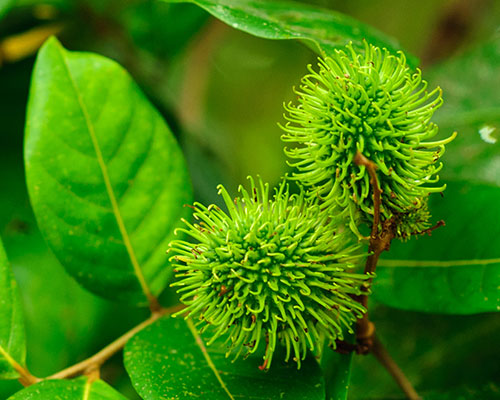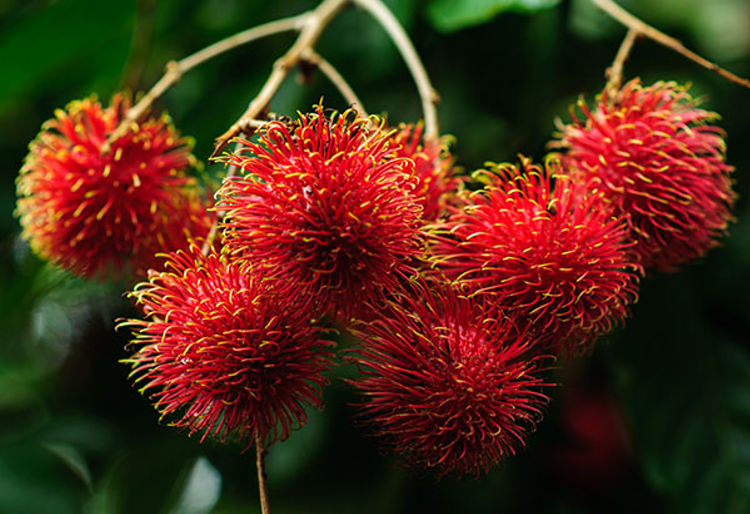Mamón chino are sold on practically every corner in Costa Rica between the months of July and October.
COSTA RICA EXTRA – (We Love Costa Rica) Mamón chino are sold on practically every corner in Costa Rica between the months of July and October. If you’ve ever tasted these spikey, irresistible sweets then you’re probably an addict, too. If not, don’t fret. You will be soon.
What is mamón chino and where does it come from?
 Remember Sweet Tarts — those sweet and sour circular candies that came in rolls that old people always gave out on Halloween? Well, think of the mamón chino fruit as nature’s organic “sweet tart.”
Remember Sweet Tarts — those sweet and sour circular candies that came in rolls that old people always gave out on Halloween? Well, think of the mamón chino fruit as nature’s organic “sweet tart.”
Mamón chino is thought to have originated in Indonesia and Malaysia, where it is called rambutan (“ram-boo-tan”). In Costa Rica, mamón chino roughly translates to “Chinese sucker.” Since that doesn’t really have a nice ring to it in English, they’re often called hairy lychees (fun fact: they aren’t technically lychees, but they are closely related).
Here, we call them mamones (“ma-moan-nez”) for short. These suckers grow on beautiful farms, primarily in the Caribbean and the Osa Peninsula (picture an apple orchard littered with prickly tropical orbs instead of apples). Once a tree has matured enough to bear fruit, green thorny balls will appear that gradually turn red as they ripen over the course of about 6 months.
Then Costa Rica turns into a mamón eating free-for-all.
How do you eat them?
 For beginners, this hairy, funny-looking fruit can look quite intimidating to eat. Fear not — devouring them is easy. Just slice open the lychee around the center with a small knife (or your fingernails), and pop off the top. Or if you’re really impatient, gnaw at it with your teeth until you’ve exposed the fleshy insides.
For beginners, this hairy, funny-looking fruit can look quite intimidating to eat. Fear not — devouring them is easy. Just slice open the lychee around the center with a small knife (or your fingernails), and pop off the top. Or if you’re really impatient, gnaw at it with your teeth until you’ve exposed the fleshy insides.
Once you’ve chucked the red spiked shell, pop the smooth white oblong sphere into your mouth. Gently chew or suck on it until you’re left with nothing but the seed, which you can spit out and throw away (although I have also heard that you can boil the pits and eat them for an extra nutritional kick).
It’s impossible to eat just one. So if you pick up a bag of them and plan on sharing, be sure to get 1 kilo for each person to avoid mamón chino-related violence.
Varieties
There are more flavors and varieties of mamón chino than I can describe here. Each tree grown from seed on any given farm has it’s own ‘personality’ and bears fruit that tastes completely different from its neighbor-trees (this is not quite true for the grafted variety).
“Injertados,” or “grafted” mamónes are slightly more expensive because the fruit is harvested from branches of very specific, high quality hybrid trees. They are worth the extra dollar or two, because the pulp of grafted rambutan is consistently sweet and falls off the seed cleanly and effortlessly. Click here to learn more about grafting and what it means.
 In Guanacaste, you can pick up a bag of regular mamónes for about 1500 colones ($3) a kilo, or injertados for 2500 colones ($5) a kilo. In the Caribbean or the Osa Peninsula, closer to where they are grown, you can usually pick them up for half the price.
In Guanacaste, you can pick up a bag of regular mamónes for about 1500 colones ($3) a kilo, or injertados for 2500 colones ($5) a kilo. In the Caribbean or the Osa Peninsula, closer to where they are grown, you can usually pick them up for half the price.
Nutrition Facts
Just 100 grams of mamon chino provides about 66% of your daily Vitamin C requirement. I’m pretty sure no one in the history of time has been able to stop at just 100 grams, so you can bet you’ll get well over the recommended Vitamin C in one sitting.
Article by posted on We Love Costa Rica








